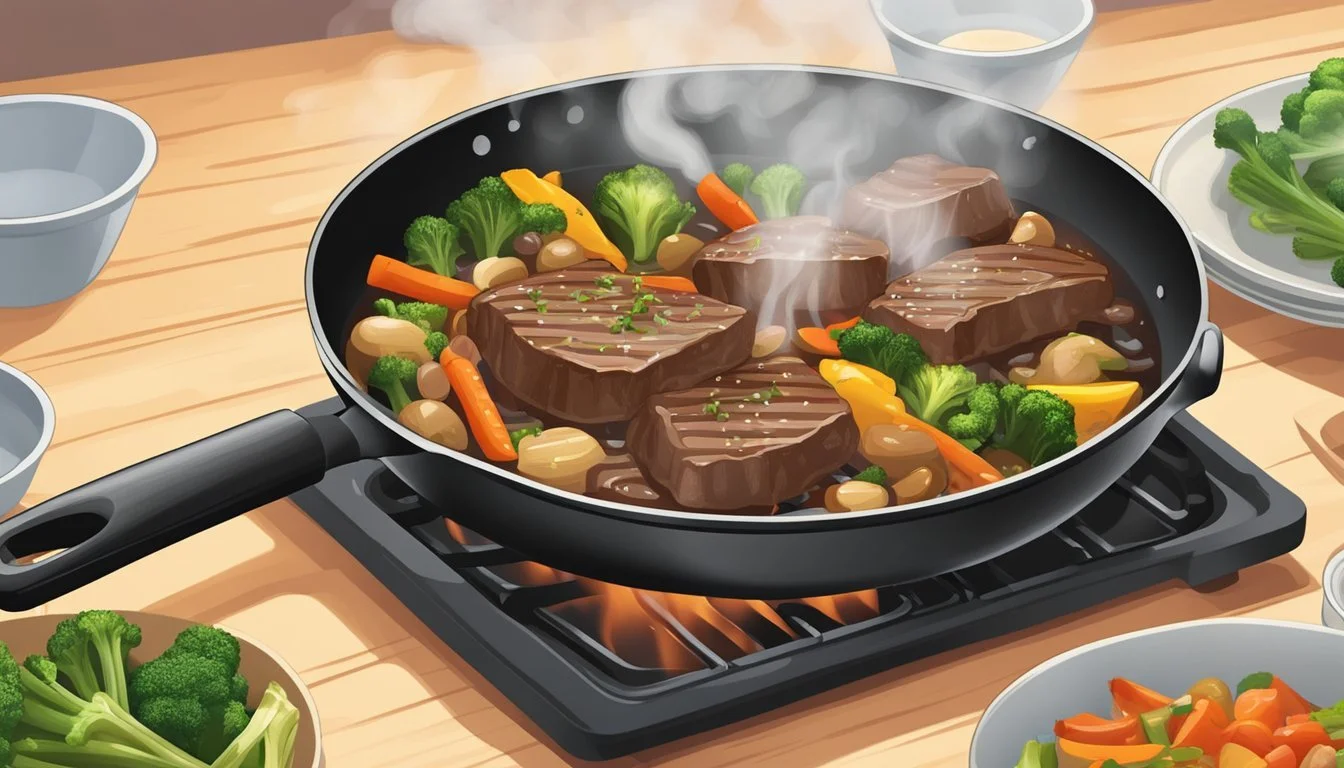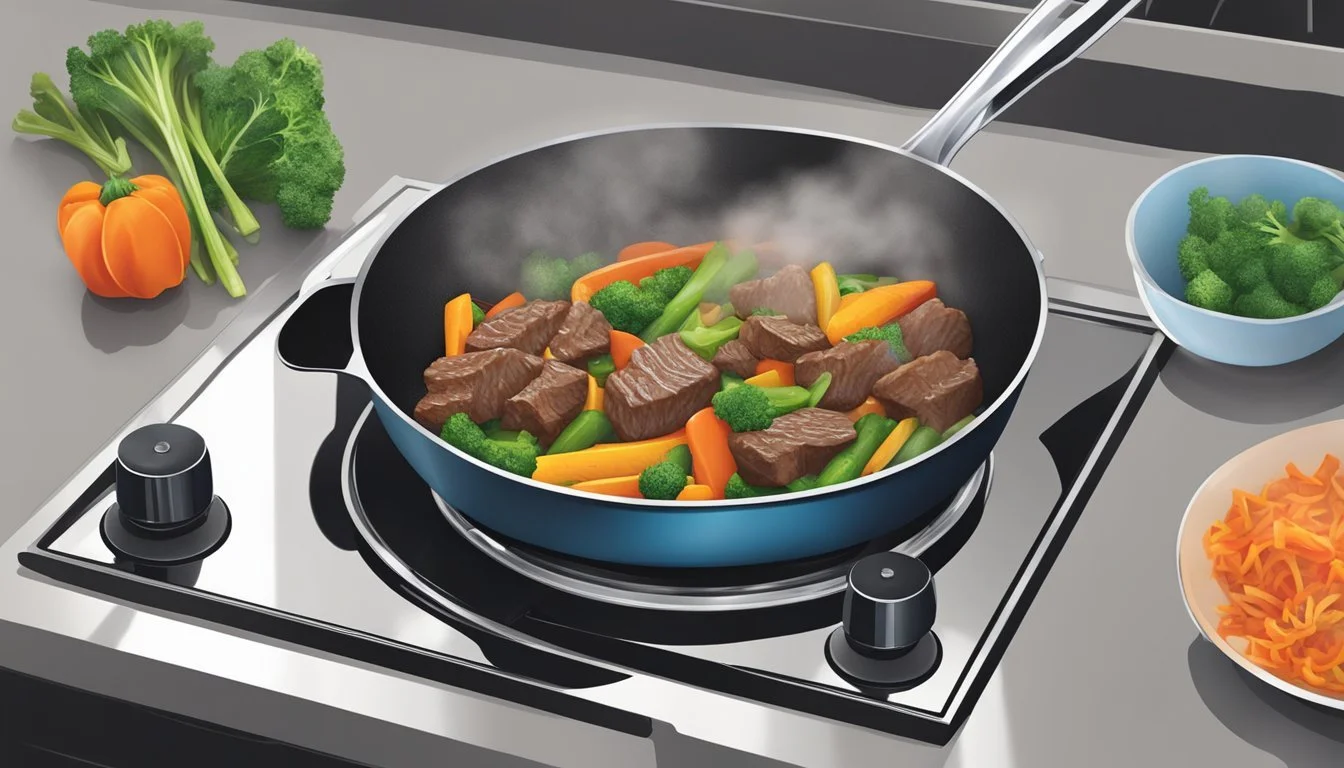How to Reheat Beef and Vegetable Stir-Fry
Best Methods and Tips
Reheating beef and vegetable stir-fry can be a great way to enjoy leftovers without sacrificing taste or texture. To reheat beef and vegetable stir-fry, the best method is to use a stovetop with a wok or skillet, adding a bit of oil to reinvigorate the flavors. This method ensures the beef remains tender and the vegetables stay crisp, providing a meal that is almost as good as when it was first cooked.
Using a microwave is a quick and convenient alternative, although it may compromise the dish's original texture. To reheat, place the stir-fry in a microwave-safe dish, cover it loosely, and heat for short intervals until it’s warm. This method can save time but might result in slightly soggy vegetables and tougher beef.
For those with an air fryer, reheating stir-fry can yield surprisingly good results. Preheat the air fryer to a moderate temperature, spread the stir-fry in a single layer, and heat until it’s warmed through. This method can help maintain the dish’s original crispness while bringing back the flavors effectively.
Understanding Reheating Methods
Reheating beef and vegetable stir-fry can be done effectively using several methods, each with its specific technique to preserve texture and flavor. The following sections detail the methods using the stove, microwave, oven, and air fryer.
Stove Method
The stove method is great for controlling texture and flavor.
Heat a pan over medium heat with a small amount of oil. Spread the stir-fry evenly in the pan. Stir occasionally to ensure even reheating. This method helps retain the dish's original texture and flavor, avoiding common reheating pitfalls like sogginess or dryness.
Monitor the temperature closely to avoid overcooking. The stovetop method allows for quick reheating while preserving the quality of the dish.
Microwave Method
The microwave method is convenient for quick reheating.
Place the stir-fry in a microwave-safe dish and cover it with a damp paper towel to retain moisture. Set the microwave to medium power and heat for 90 seconds. Check for even heating and stir the dish before microwaving for an additional 60-90 seconds if needed.
Be careful of uneven heating spots typical in microwaves. Stirring midway helps distribute heat evenly, maintaining the flavor without drying out the dish.
Oven Method
Reheating in the oven ensures even heating for larger portions.
Preheat the oven to 350°F (175°C). Spread the stir-fry on a baking tray lined with aluminum foil. Cover the stir-fry loosely with another piece of foil to prevent it from drying out. Bake for 10-15 minutes, checking periodically to ensure it heats evenly.
This method retains moisture and evenly reheats the dish, making it ideal for maintaining both texture and flavor.
Air Fryer Technique
The air fryer method is perfect for keeping the stir-fry crispy.
Preheat the air fryer to 350°F (175°C). Place the stir-fry in the air fryer basket in a single layer, ensuring it is not overcrowded. Air fry for about 5 minutes, stirring halfway through to ensure even heating.
This technique uses high heat to maintain crispness, making it ideal for reheating without sacrificing the original texture and flavor of the dish.
Preparation for Reheating
Reheating beef and vegetable stir-fry properly ensures that it is safe to eat and retains its original taste and texture. Key points include taking appropriate food safety measures and optimizing the individual components of the stir-fry for the best results.
Food Safety Precautions
Ensuring food safety is crucial when reheating stir-fry. Leftovers should be stored in an airtight container and refrigerated within two hours of cooking. Keeping the stir-fry below 40°F helps prevent bacterial growth.
Prior to reheating, check that the food has been refrigerated at a consistent temperature. Avoid leaving stir-fry at room temperature for extended periods, as this can compromise safety. Reheat leftovers to an internal temperature of at least 165°F to kill any potential bacteria.
Optimizing Stir-Fry Components
Maintaining the quality of the stir-fry's components is essential. Veggies can become soggy, so consider adding a small amount of oil when reheating to maintain their texture. Reheating on mediums such as a skillet or an air fryer works well to keep the stir-fry crispy.
For proteins like beef, ensure they are spread evenly and not overcrowded during reheating. This promotes even heating and prevents moisture loss. If reheating rice or stir-fry noodles, add a splash of water or soy sauce before reheating to keep them from drying out.
Taking these steps ensures that your reheated stir-fry tastes as delicious as it did when freshly made.
Reheating Best Practices
When reheating beef and vegetable stir-fry, it's essential to maintain flavor, texture, and avoid common issues like sogginess or dryness. Careful attention to techniques and ingredients helps retain the dish's quality.
Avoiding Common Mistakes
High heat is critical for reheating stir-fry, helping to restore its crisp texture and freshness. Using a pan or wok on the stovetop is ideal. Preheat the pan before adding the stir-fry to ensure even heating. Avoid using the microwave as it often leads to uneven heating and soggy vegetables.
Adding a touch of oil, such as peanut oil or vegetable oil, can prevent the stir-fry from drying out during reheating. Refrain from adding too much liquid to avoid sogginess. If your stir-fry has become too wet, draining excess moisture with a paper towel helps preserve the desired texture. Be mindful of overcooking; reheating should be quick, primarily to warm the ingredients without further cooking them.
Enhancing Flavor and Texture
To revive the flavors, consider adding a bit more seasoning or sauce during reheating. This can compensate for any flavor lost if the dish has been refrigerated. Freshening up vegetables by adding a few new ones, or tossing in some fresh herbs, can enhance the crispness and flavor.
Maintaining texture is crucial. High heat helps keep vegetables crisp. Avoid stirring too frequently to prevent breaking them down. Using a high-smoking-point oil, such as peanut oil, can aid in achieving a slight crisp on the meat and vegetables without burning them. Ensure that the reheating process is brief to avoid compromising the quality of the beef.
By following these practices, reheated stir-fry can retain much of its original appeal, offering a delicious meal even the second time around.
Supplementary Tips
Understanding the right oils to use and taking health considerations into account are crucial steps in reheating beef and vegetable stir-fry. The following subsections will guide you through these aspects to ensure a tasty and healthy meal.
Choosing Appropriate Oils
Selecting the right oil is key. Peanut oil and avocado oil are excellent choices for reheating stir-fry due to their high smoke points and distinctive flavors. Peanut oil, being robust and nutty, complements the rich flavors of beef and vegetables.
Peanut oil: High smoke point, nutty flavor
Avocado oil: Mild taste, high smoke point, heart-healthy fats
Avoid vegetable oil if possible, as it may contain unhealthy trans fats. Instead, opt for oil that enhances both the taste and nutritional profile of the dish. Using the right oil helps in retaining the crisp texture and avoiding sogginess.
Health Considerations
Reheating stir-fry with health in mind involves not just the method but also the ingredients. Monitor sodium levels by using low-sodium soy sauce and be mindful of added sugars and unhealthy fats.
Low-sodium soy sauce reduces salt intake
Fresh veggies retain more nutrients during reheating
Use minimal oil to keep calories in check
Consider using lean cuts of beef to reduce fat content. Also, including a splash of broth or water can keep the stir-fry moist without adding unnecessary calories. These steps help maintain a balanced and healthy meal.
Final Thoughts
When it comes to reheating beef and vegetable stir-fry, proper techniques ensure the dish remains tasty and safe. Leftover stir-fry can be just as delicious as when it was freshly made if stored and reheated correctly.
Storage Tips:
Store leftover stir-fry in an airtight container.
Refrigerate promptly to maintain freshness.
Ensure the stir-fry is cool before sealing it.
Reheating Methods:
Microwave:
Use a microwave-safe dish.
Cover with a paper towel.
Reheat on medium power for 90 seconds, then check doneness.
Stovetop:
Heat a pan on medium.
Add stir-fry with a bit of oil or water.
Stir occasionally until heated through.
Air Fryer:
Set to 350°F.
Place stir-fry in a makeshift foil bowl.
Air fry for 5 minutes, stirring halfway.
Oven:
Preheat to 350°F.
Spread stir-fry on a baking tray.
Heat for 10 minutes, adding oil or water for moisture.
Each method has its benefits, allowing for flexibility depending on available equipment. Microwave and stovetop are quick options, while the air fryer and oven retain more texture.
Always check the reheated food to ensure it’s hot throughout. Proper reheating not only makes the stir-fry enjoyable but also keeps it safe to eat.




